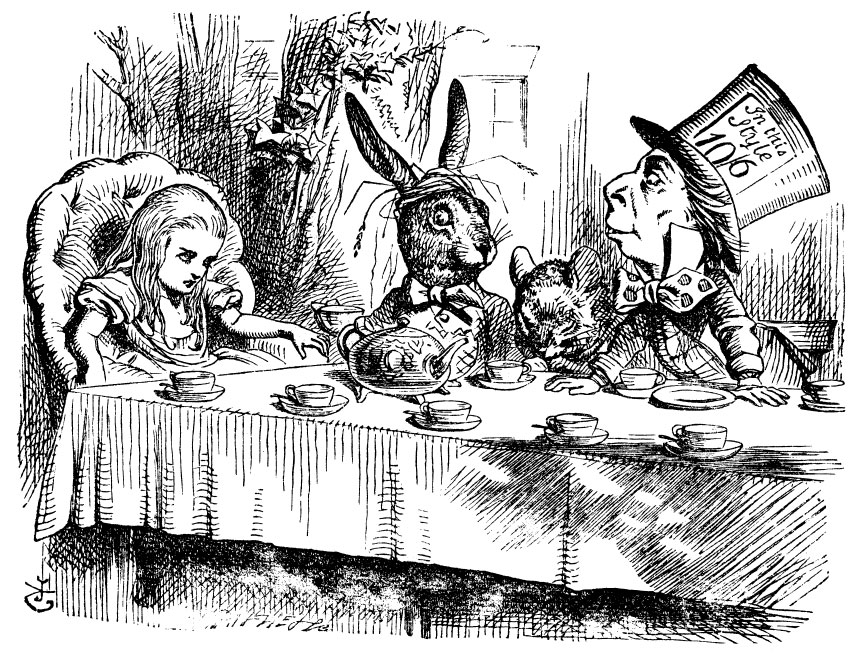Piece by Stephanie Pradier, The Science Show.
They wrote for children, but they also did science – this was the theme for ABC Radio National’s Science Show on Saturday May 9.
AMSI’s Stephanie Pradier joined Robyn Williams and other scientists with her piece that jumped down the rabbit hole into the sensical nonsense and maths in wonderland.
You can download the podcast on the Science Show website here
Or read the transcript below:
Being read Alice in Wonderland as a child one only thinks of the adventures she has. The white rabbit, the caucus race, treats that make you grow and shrink. I remember Alice meaning a world of mysteries below the ground. I was frightened of the Queen of Hearts and delighted by the game of croquet.
As a young woman with degrees in both physics and philosophy re-reading Alice I have discovered so much more and it means so much more. The play on words; the puns; the homophones; the mathematical inverses; the nonsensical logic, hidden throughout. Alice is just as entertaining in my late twenties as it was in early childhood.
Alice is 150 years old this year, but her adventures in Wonderland read for the first or the hundredth time, seem as young and vibrant as ever.
The majority of people today know Lewis Carroll was but a pseudonym for the mathematician Charles Lutewidge Dogdson. Carroll constructed his pen name through a series of steps. He took the first two parts of his name Charles Lutwidge and translated them into Latin: Carolus Ludovicus. He then reversed the order and loosely translated them back into English. And, he was left with Lewis Carrol.
So how did this meticulous and conservative mathematician write such a fantastical tale?
I actually believe that:
If Carroll was not a mathematician and logician, then the tales would not have been fantastical.
As this is a conditional statement logic tells us its contrapositive must also be true:
The fantasticality of the tales requires that Carroll was both a logician and mathematician.
Carroll is bred from a long line of mathematical clergymen. His father lived at Christ Church College, as did he. He father was a Church of England Cleric, as was he. And his father was an Oxford Don in mathematics, as was he.
One thing Carroll didn’t do, which his father did, was marry. Carroll lived and died, a bachelor, at Christ Church College.
Throughout his lifetime Carroll printed 256 pieces of writing. Sixteen of these were books: ten devoted to mathematics and logic, six to children.
When reading about Carroll’s life as a mathematician we find first and foremost, that he was a teacher, a teacher earnestly concerned with methods of instruction.
One of the books he wrote on mathematics was entitled “Pillow Problems.” This work contained 72 mathematics puzzles Carroll worked out in his head when suffering insomnia. It is said that Carroll, a private man, did not wish for anyone to know of his insomnia, so he changed the subtitle of this book from “thought-out during sleepless nights,” to “thought-out during wakeful hours.” An example of his love of inverses – to which I will come to shortly.
Carroll wrote of this small book: “Mathematics will not put you to sleep, but it will occupy the mind pleasantly and prevent worry.”
When I stumbled upon this sentiment I instinctively agreed. Doing mathematics and logic problems most certainly occupies my mind. I find it meditative, fun, hard and satisfying.
Before going down the rabbit hole into the logics and inverses of Wonderland, let me first describe one of Carroll’s more serious questions about our reality. His question was: “Where does the day begin?” And it goes like this:
If someone is to travel westward around the earth with the same speed as the sun, they will find that though they started on a Tuesday, when they return to their starting point the day is now called Wednesday. So, asks Carroll, when did the day and date change?
Apparently Carroll made many government officials as mad as a hatter asking for an answer to this question, which he first posed in 1860. Of course, not a soul could answer him, not until 24 years later, in 1884, when the arbitrary International Date Line was established.
This shows insightful thinking and playful ideas and asking questions and questioning answerers is an imperative function of understanding the world and the human conditions we impose on it.
Carroll believed, as do I, that children (and I also think adults), would enjoy learning mathematics if they could be enticed by amusing stories and puzzles. Although times have changed and today puzzles can be solved not just pen and paper but also screen, mouse and keys, one thing required to solve puzzles for all time is imagination.
And it was Carroll’s imagination that brought us Alice.
Re-reading Alice this year I was struck and amazed by Carroll’s ingenuity.
There are many amusing homophones throughout the text and a great deal of mathematics and logic. I do not nearly have enough time to go through them all, so I have chosen but two of my favourites and a few words to play with.
When the Cheshire cat first appears to Alice, at a fork in the road, she is faced with a dilemma. The Cat tells Alice whichever path she chooses she will encounter mad people.
“But I don’t want to go among mad people,” Alice remarked.
“Oh you can’t help that,” said the Cat: “we’re all mad here. I’m mad. You’re mad.”
“How do you know I’m mad?” said Alice.
“You must be,” said the Cat, “or you wouldn’t have come here.”
Alice didn’t think that proved it at all: however, she went on: “And how do you know that you’re mad?”
And this is my favourite piece of faulty reasoning:
“To begin with,” said the Cat, “ a dog’s not mad. You grant that?”
“I suppose so,” said Alice.
“Well, then,” the Cat went on, “you see, a dog growls when it’s angry, and wags it’s tail went it’s pleased. Now I growl when I am pleased, and wag my tail when I’m angry. Therefore, I’m mad.”
What a cunning little logical trick.
Carroll inverts everyday mathematical and scientific concepts. The most famous is the episode where the Red Queen takes Alice by the hand and begins to run. The pair run faster and faster but they remain in the same place. “It takes all the running you can do to stay in the same place,” says the Red Queen.
In our world speed is defined as the change in distance over time. In Wonderland and Looking Glass Land, were everything is inverted, it makes perfect sense that speed is the ratio of time to distance. And therefore it is perfectly sound logic that the White Queen screams before she pricks her finger and that the faster you run the shorter the distance you cover.
And then there are all the homophones — words that sound the same but have different meanings — and plays on words. But I think it is best for you to see these for yourself.
At first sight Carroll seems an unlikely person to have written these immortal works. But as we delve deeper into his studies and his life, the less extraordinary does the paradox seem.
Nonsense opens our minds to the infinite possibilities of our world, and allows us to think of six impossible things before breakfast.
I believe the human soul needs nonsense, just as it needs art, literature, music, and maths.
And perhaps, if like Carroll, we expose children to the sensical and nonsensical aspects of mathematics they may themselves jump down the rabbit hole.



